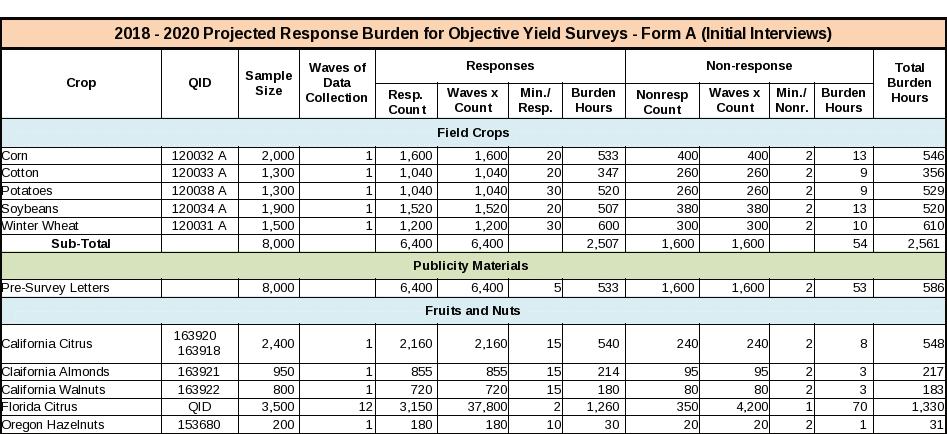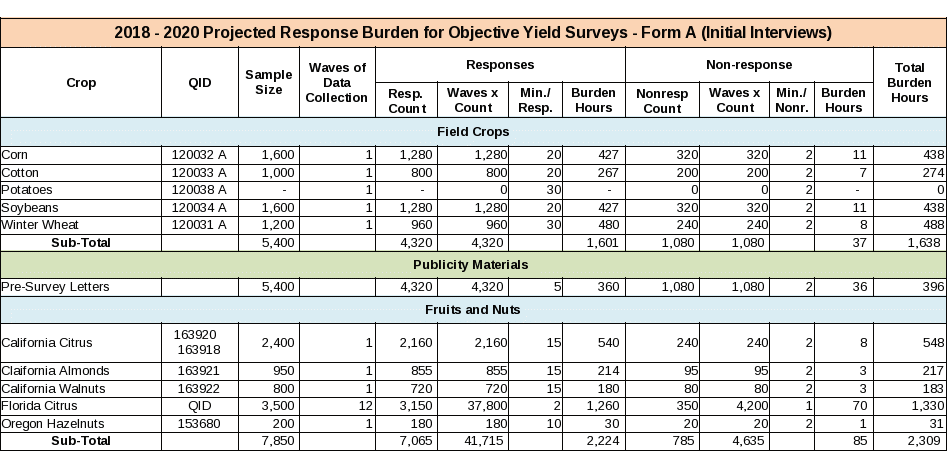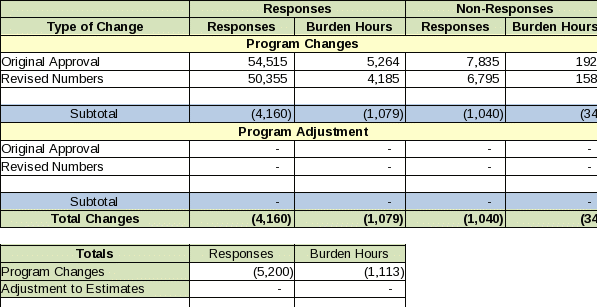Supplemental Supporting Statement Part A for Objective Yield Substantive Changes
0088-OY-20-SSA-Substantive Change - Feb 2020.docx
Field Crops Objective Yield - Non-Substantive Change
Supplemental Supporting Statement Part A for Objective Yield Substantive Changes
OMB: 0535-0088
Supporting Statement
FIELD CROPS OBJECTIVE YIELD SURVEYS
OMB No. 0535-0088
Substantive Change Request
This substantive change is being submitted as a supplemental supporting statement to the Field Crops Objective Yield program.
A. JUSTIFICATION
1. Explain the circumstances that make the collection of information necessary. Identify any legal or administrative requirements that necessitate the collection. Attach a copy of the appropriate section of each statute and regulation mandating or authorizing the collection of information.
The National Agricultural Statistics Service (NASS) is requesting a substantive change to the Objective Yield program. The changes will include the following
Eliminating Potato Objective Yield
Removing Louisiana and North Carolina from Cotton Objective Yield
Eliminating the August survey period for Cotton (except Texas), Corn, and Soybeans
Reducing sample sizes for all field crops included in this program.
Following the conclusion of each Census of Agriculture, NASS reviews our overall survey and estimation programs to see what changes or adjustments need to be made in order to optimize the funds we are provided. This is done for the purpose of achieving our primary functions of preparing and issuing State and national estimates of crop and livestock production, disposition, and prices and to collect information on related environmental and economic factors.
The complete listing of program changes adopted by NASS in 2019 can be found at https://www.nass.usda.gov/Surveys/Program_Review/index.php.
2. Indicate how, by whom, and for what purpose the information is to be used. Except for a new collection, indicate the actual use the agency has made of the information received from the current collection.
NASS will continue to publish annual production data for potatoes, cotton and the other commodities included in the Objective Yield program. This substantive change will only eliminate indications of production during the growing season for the crops listed in item 1 above. The acres planted/harvested and the yield and/or production data will come from other surveys conducted by NASS.
3. Describe whether, and to what extent, the collection of information involves the use of automated, electronic, mechanical, or other technological collection techniques or other forms of information technology, e.g., permitting electronic submission of responses, and the basis for the decision for adopting this means of collection. Also describe any consideration of using information technology to reduce burden.
There will be no changes made to the mode of data collection for the surveys that remain in this approval.
4. Describe efforts to identify duplication. Show specifically why any similar information already available cannot be used or modified for use for the purposes described in Item 2 above.
There are no changes from the original approval related to duplication reduction.
5. If the collection of information impacts small businesses or other small entities (Item 5 of OMB Form 83-I), describe any methods used to minimize burden.
The discontinuation of the surveys listed above in item 1 will reduce the number of small farmers who will be contacted to 11,300.
6. Describe the consequence to Federal program or policy activities if the collection is not conducted or is conducted less frequently, as well as any technical or legal obstacles to reducing burden.
There are no changes to the frequency of the surveys that remain in this docket approval from what was originally approved.
7. Explain any special circumstances that would cause an information collection to be conducted in a manner inconsistent with the general information guidelines in 5 CFR 1320.5.
There are no special circumstances associated with this information collection.
8. Provide a copy and identify the date and page number of publication in the Federal Register of the agency's notice, required by 5 CFR 1320.8 (d), soliciting comments on the information collection prior to submission to OMB. Summarize public comments received in response to that notice and describe actions taken by the agency in response to these comments.
Not applicable.
Describe efforts to consult with persons outside the agency to obtain their views on the availability of data, frequency of collection, the clarity of instructions and recordkeeping, disclosure, or reporting format (if any), and on the data elements to be recorded, disclosed, or reported.
Following the publication of the NASS program changes to our internet homepage (https://www.nass.usda.gov/Surveys/Program_Review/index.php) in March 2019; NASS did receive numerous comments from the public regarding these changes (crops and livestock). NASS commodity statisticians and managers responded to the phone calls and emails that were received.
9. Explain any decision to provide any payment or gift to respondents.
There are no payments or gifts to respondents.
10. Describe any assurance of confidentiality provided to respondents and the basis for the assurance in statute, regulation, or agency policy.
There are no changes to the confidentiality that was approved under the original docket.
11. Provide additional justification for any questions of a sensitive nature.
There are no questions of a sensitive nature.
12. Provide estimates of the hour burden of the collection of information. The statement should indicate the number of respondents, frequency of response, annual hour burden, and an explanation of how the burden was estimated. If this request for approval covers more than one form, provide separate hour burden estimates for each form and aggregate the hour burdens in Item 13 of OMB Form 83-I. Provide estimates of annualized cost to respondents for the hour burdens for collections of information, identifying and using appropriate wage rate categories.
The only commodities that will be impacted by this substantive change are corn, cotton, potatoes, soybeans, and winter wheat. The fruit and nut surveys are conducted under cooperative agreements with the respective State Departments of Agriculture
The following table contains the estimated change to burden hours for the surveys included in this supplemental supporting statement. Cost to the public for completing the questionnaire is assumed to be comparable to the hourly rate of those requesting the data. The adjusted overall cost to the public is estimated at $159,996.12.

NASS uses the Bureau of Labor Statistics’ Occupational Employment Statistics (most recently published on March 29, 2019 for the previous May) to estimate an hourly wage for the burden cost. The May 2018 mean wage for bookkeepers was $20.25. The mean wage for farm managers was $38.43. The mean wage for farm supervisors was $24.42. The mean wage of the three is $27.70. To calculate the fully loaded wage rate (includes allowances for Social Security, insurance, etc.) NASS will add 33% for a total of $36.84 per hour.

Original Burden Table

Revised Burden Table

13. Provide an estimate of the total annual cost burden to respondents or record keepers resulting from the collection of information.
There are no capital/start-up or ongoing operation/maintenance costs associated with this information collection.
14. Provide estimates of annualized cost to the Federal government; provide a description of the method used to estimate cost which should include quantification of hours, operational expenses, and any other expense that would not have been incurred without this collection of information.
These program cuts are projected to reduce the total expenses for the Objective Yield surveys by approximately $1 million. The remaining surveys are expected to cost approximately $4.3 million annually. The total cost includes all expenses for Federal salaries, NASDA field enumerator costs, training State and Regional Field Office staff, mileage, telephone, printing, overhead, and other miscellaneous costs.
15. Explain the reasons for any program changes or adjustments reported in Items 13 or 14 of the OMB Form 83-I (reasons for changes in burden).
The reduction in burden hours and number of responses due to these changes are displayed in the following table.

16. For collections of information whose results will be published, outline plans for tabulation and publication. Address any complex analytical techniques that will be used. Provide the time schedule for the entire project, including beginning and ending dates of the collection of information, completion of report, publication dates, and other actions.
There are no changes the tabulation and publication plans that are described in the original approval other than the omission of any reports associated the deleted commodities.
17. If seeking approval to not display the expiration date for OMB approval of the information collection, explain the reasons that display would be inappropriate.
No approval is requested for non-display of the expiration date.
18. Explain each exception to the certification statement identified in Item 19, “Certification for Paperwork Reduction Act Submissions” of OMB Form 83-I.
There are no exceptions to the certification statement.
February 2020
| File Type | application/vnd.openxmlformats-officedocument.wordprocessingml.document |
| File Title | Supporting Statement |
| Author | hancda |
| File Modified | 0000-00-00 |
| File Created | 2021-01-14 |
© 2026 OMB.report | Privacy Policy